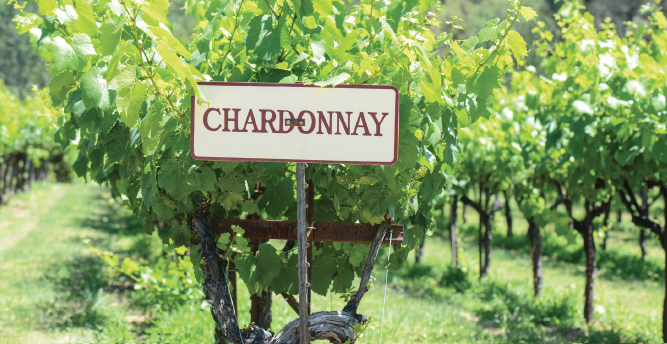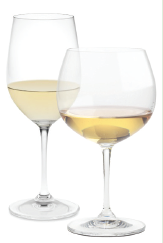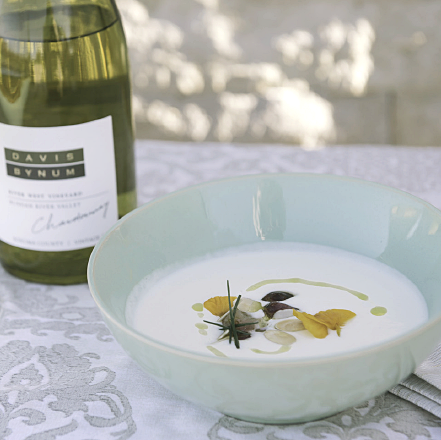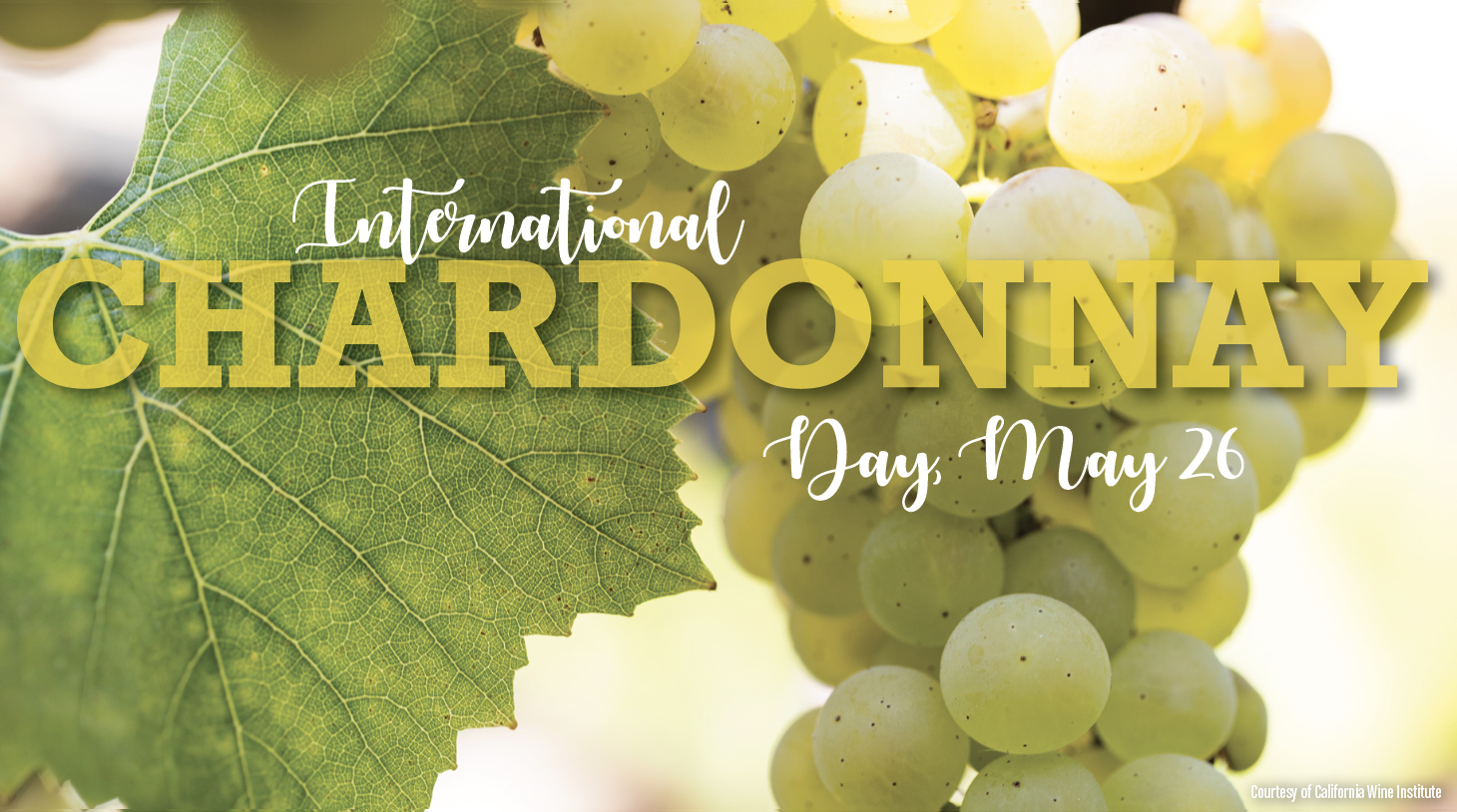Celebrate Chardonnay Day, May 26!
Travel to just about any wine region in the world and you’ll find Chardonnay. It’s considered an adaptable winemaker’s grape that can handle almost anything thrown at it.
Chardonnay was born in the Burgundy region of France, where it is often referred to as White Burgundy. Recent DNA research from UC Davis in California found that Chardonnay is a result of the cross between Pinot Noir, Pinot Blanc and Gouais Blanc. There are few Gouais Blanc vines remaining and most of them are found in Germany. It is not certain when or where the crossbreeding occurred but estimates conclude that the Romans planted Gouais Blanc in French soils where Pinot Noir were planted and nature then took its course.
The vine was planted in Champagne and the grape became one of the dominant varieties for the famous French sparkling wines. But it is in Burgundy, where the wine gained its reputation as an elegant white wine. Lovely dry white wine expressions of Chardonnay can be found in the cool-climate of Chablis, as well as the notable Côte d’Or, where the finest, and most expensive, wines are often found. The Mâconnais in the south end of Burgundy also produces larger volumes of Chardonnay that is more affordable.
While France is certainly the grape’s spiritual home, especially in the various Burgundy appellations, the grape also produces high quality wine in many parts of the world including the United States, New Zealand, Australia, Chile, South Africa and several other countries. In the United States, it is grown in numerous states from coast to coast with its greatest success found in Sonoma Coast appellations of Northern California. Some of the best Chardonnay in California can be found in Sonoma County mostly from the Russian River Valley, Carneros and Coastal areas. Chardonnay also enjoys great success in the Santa Barbara and Central Coast appellations.
In general, California Chardonnay can be separated into two distinctive styles. One is fuller bodied with rich, juicy fruit that is fermented and aged in lots of new oak. The other can be lean and restrained with more French-style notes and European temperament. This kind can be either oaked and aged in neutral oak, stainlesss steel or concrete. Today, there are about 34 different clones of Chardonnay that offer different expressions of the varietal.

get the dirt
Understanding terroir and its influences
Chardonnay is light green in color and a relatively easy growing grape that gracefully adapts to a wide range of terroir and conditions. It takes on unique and different characteristics depending on the specific region and area and soil it grows. No two places that grow Chardonnay produce the exact same wine. In addition, the treatment of the grape in the winery will dictate the wine’s final style just as much as the appellation of the sourced fruit.
While Chardonnay produces good quality fruit under a variety of conditions, the best expression of the grape comes from soils that have high concentrations of chalk, clay and limestone. There are a couple of winemaking techniques and processes that influence the final product of a Chardonnay. One typical process is called malolactic fermentation which is used to soften harsh acids and bring out creamy dairy flavors. Another process is called ‘on the lees’ which is a term used when the wine is left to sit on the dead yeast cells after fermentation which offers flavors of cheesiness to the wine. Then, Chardonnay is often aged in oak which adds flavors of baking spices, toast and vanilla depending on the style, origin and age of the oak.
swirl, sniff, sip, savor
How to identify wine in the glass
The flip side to Chardonnay’s easy growing nature is that its flavors can be quite varied depending on terroir, conditions and winemaking techniques. It is a white wine that can be simple or stoic, youthful and fresh or aged, consumed in the present moment or set aside. The grape can produce a dry wine as well as Champagne, sparkling and dessert wines. It can also be made to taste crisp and stony, buttery and toasty, or brilliantly fresh and sparkly.
Expect the wine flavor of the Chardonnay to be representative of where it was grown. For example, Chardonnays from cooler regions will have more acidity and fresher structure leading to more citrus flavors and subtle floral essences. These wines tend to be more lean and crisp. On the other side, the warmer climate Chardonnays will be more sweet and reflect the more tropical flavors of pineapple, mango and guava. These wines tend to be more fuller-bodied with stronger buttery flavors.
Overall, expect strong fruity profiles ranging in notes from crisp green apples to baked apple pie, tropical zesty pineapple to lemon curd and pineapple upside-down cake, and lean minerality to spices and smoke.

what’s in the glass?
Would wine in any other glass smell as sweet?
White wines are typically served in smaller bowled glasses that preserve the floral aromas and maintain their cooler temperature, but as with all things Chardonnay, the style of the wine will determine the glassware used. A classic Chardonnay glass is considered a “standard” white wine glass. Fuller-bodied Chardonnays, however, may benefit from a larger bowled glass similar to a Red Burgundy or Pinot Noir glass.
how to pair like a pro
Chardonnay comes in a wide variety of styles with different structures, levels of sweetness and acidity. Because of this adaptability, there are an equally diverse array of wine and food pairings that work with Chardonnay making it a relatively easy wine to choose for many different dishes.
Typically all types of seafood from shell fish to grilled fish pair well with Chardonnay. Depending on the way the seafood is prepared will determine the style of Chardonnay to choose. A richer Chardonnay will work better with a buttered, meatier, fatty fish such as salmon, crab or lobster, while a crisp Chardonnay fits a flaky fish, shrimp or scallops better. Lean, mineral-driven Chardonnay will go well with raw seafood dishes, as well.
For meat lovers, white meats such as grilled chicken, smoked turkey, veal with cream sauce and pork are all good pairings with Chardonnay. Again, depending on the preparations of the dish will determine the style of the Chardonnay that works best with the food. In general, the simpler the preparations, the leaner the Chardonnay to pair with it.
There is a lively natural acidity in Chardonnay that makes a perfect pairing with a wide variety of hard and soft cheeses, as well as creamy cheeses like baked brie with almond slices and apples. Consider semi-soft mild goat and cow’s milk cheeses such as Humboldt Fog or a simple white mild cheddar cheese with your next glass of Chardonnay. For a completed cheese tray, add cut apples, figs or artichokes to round out the flavor palate.
Vegetarians will find Chardonnay goes well with many dishes especially those that have fresh herbs and spices of tarragon, parsley, thyme, lemon zest, marjoram, white pepper mixed with yellow squash, peas, zucchini, asparagus, sun chokes, white mushrooms, truffles, chanterelles and slivered almonds.
With its versatility and all-around good nature, Chardonnay is one of the the world’s most popular grape for white wine. It is the fifth most widely planted grape variety and its long standing popularity has awarded the grape its own holiday.

Cream of Cauliflower Soup, Roasted Grapes and Almonds
4 servings
Cauliflower Soup
1 small cauliflower, cleaned and trimmed
1 yellow onion, sliced
1 bay leaf
2 cups heavy cream
2 cups vegetable stock
Salt, white pepper and fresh lemon juice
Roasted Grapes
1 cup red seedless grapes
1 sprig thyme
Salt
Olive Oil
1) In a large saucepan heat olive oil at medium heat, add onion and sweat until tender, add cauliflower and coated with the oil, pour the stock, bay leaf and cream.
2) Bring to simmer and cook until the cauliflower is tender, remove bay leaf.
3) Strain out the solids and puree in batches with a little bit of the liquid until smooth, season with salt, white pepper and little bit of lemon juice.
4) In a baking pan, mix the grapes, thyme, drizzle with olive oil and pinch of salt, bake in a 400° oven, until grapes are beginning to blister, 10 to 15 minutes.
5) Garnish the soup, with almonds and roasted grapes.
Suggested Wine Davis Bynum Chardonnay
Compliments of Rodney Strong Vineyards
